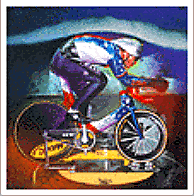AERODYNAMICS have preoccupied bicycle designers since the early part of this century. The most advanced bicycles today are deployed in track racing. The recently unveiled SB II, or Superbike II, has
a lightweight carbon-fiber frame. It also has a range of aerodynamic design elements. Similar features are incorporated into bicycles for some road-racing events in which Lance Armstrong competes.

As the bicycle and its rider move along the road, the air exerts a force that increases sharply with speed. The force is due to friction between the air and the exposed surfaces of the rider and
bicycle. At high speed, this drag force can be the most importance source of resistance, and with a wind blowing, it can also lead to significant side
forces.
The aerodynamic forces on any vehicle come primarily from differences in pressure and viscous shearing
stresses. Both types of forces ("pressure" drag and "friction drag") arise because all real fluids have viscosity. Viscosity is
a basic property of fluids. The viscosity of air is very small, but it is not negligible.
Frictional drag comes from friction between the air flow and the surfaces exposed to the air flow. This friction arises because air (and other
fluids) has viscosity. Viscosity is associated with the ability of a fluid to flow freely. For example, honey has about 100 times the
viscosity of water, and it is obvious that the two fluids flow differently, and that it takes much greater force to stir honey than water.
The frictional drag also depends on the Reynolds number, because the flow is laminar at low Reynolds numbers, and turbulent at high Reynolds numbers. Pressure drag comes from the the eddying motions that
are set up in air by the passage of the rider. This part of the flow is called the wake, and it is similar to the flow left behind a
passing boat. It is generally not a strong function of Reynolds number.

There is an important connection between velocity and pressure, expressed in Bernoulli's equation (for inviscid flows), and between velocity and cross-sectional area, expressed in the continuity equation.
There are also two kinds of bodies: streamlined bodies and bluff bodies. A
streamlined body looks like a fish, or an airfoil, and the streamlines go smoothly around the body A bluff body looks like a brick, or a cylinder,
and the streamlines break away whenever a sharp change in direction occurs. For streamlined bodies, the frictional drag is the dominant source of air resistance. For a bluff body, the dominant source
of drag is the pressure drag. It is always true that, for a given frontal area and speed, a streamlined body will have a lower air resistance than a bluff body.
The biggest difference between streamlined and bluff bodies is that in streamlined flow, the regions where losses occur are inside boundary layers and wakes that remain reasonably thin, whereas in bluff bodies, adverse pressure gradients cause the boundary layers to separate, which creates a large wake filled with energetic eddies which dissipate a great deal of mechanical energy and thereby increase the drag.
Parts of a rider and bicycle combination act like a streamlined body, whereas other parts behave like a bluff body. By understanding some basic aerodynamic principles, it becomes possible to identify
these components, understand the magnitude of their different contributions to the overall drag, and see how we can reduce the overall drag by altering the shape of the component parts.

